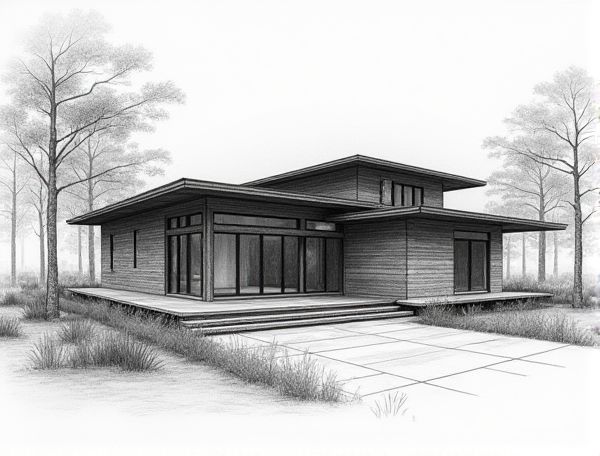
Photo illustration: Shou Sugi Ban home design with charred cedar façade
Shou Sugi Ban home design features a charred cedar facade that enhances durability and offers a distinctive, sleek aesthetic resistant to weather and pests. Discover how this traditional Japanese technique can transform Your home's exterior by reading more in the article.
Introduction to Shou Sugi Ban and Charred Cedar Façades
Shou Sugi Ban is a traditional Japanese technique of preserving wood by charring its surface, enhancing durability and resistance to weather and pests. Charred cedar facades created with this method offer a striking, textured appearance while providing natural fire retardance and increased lifespan. This sustainable approach combines aesthetics and functionality, making it popular in modern home design.
Historical Origins of Shou Sugi Ban Technique
Shou Sugi Ban, originating in 18th-century Japan, is a traditional wood preservation technique involving charring cedar boards to increase durability and resistance to pests. This method emerged from the need to protect wooden homes in Japan's humid climate and harsh winters, enhancing the wood's water resistance and fire retardancy. The technique's historical significance lies in its sustainable approach, combining natural materials with functional benefits that have influenced contemporary architectural design worldwide.
Unique Aesthetic Appeal of Charred Cedar Homes
Charred cedar homes offer a unique aesthetic appeal characterized by deep, rich textures and a striking blackened surface achieved through the traditional Japanese technique of Shou Sugi Ban. This natural preservation method enhances durability while creating a visually dramatic contrast that highlights architectural lines and organic wood grain patterns. The distinctive appearance of charred cedar complements modern and rustic designs, providing a timeless elegance that resists weathering and aging gracefully over time.
Durability and Weather Resistance of Charred Cedar
Charred cedar offers exceptional durability and weather resistance due to its unique carbonized surface layer, which acts as a natural barrier against moisture, insects, and UV damage. This makes it an ideal choice for exterior home design elements, providing long-lasting protection with minimal maintenance.
Sustainable and Eco-Friendly Aspects of Shou Sugi Ban
Shou Sugi Ban, a traditional Japanese technique of charring wood, enhances durability and resistance to pests, making it an eco-friendly choice for home design. This method reduces the need for chemical treatments and frequent replacements, contributing to sustainability by extending the lifespan of exterior cladding and siding materials. Its carbonized surface also minimizes maintenance while promoting natural weather resistance, supporting environmentally conscious building practices.
Modern Applications in Home Design
Modern applications in home design leverage smart technology, energy-efficient systems, and sustainable materials to enhance comfort and functionality. Integrating automated lighting, climate control, and security systems allows You to create a personalized living environment that adapts to Your lifestyle. Advanced design software and virtual reality tools enable precise planning and visualization, ensuring every detail aligns with Your vision.
Maintenance Tips for Charred Cedar Exteriors
Maintaining charred cedar exteriors requires regular inspections to identify any damage or wear on the shou sugi ban finish, preserving its natural fire-resistant properties. You should clean the surface gently with a soft brush and mild detergent to remove dirt without compromising the wood's protective char layer. Applying a natural oil-based sealant every few years enhances durability and maintains the cedar's distinctive textured appearance.
Integrating Shou Sugi Ban with Contemporary Architecture
Incorporating Shou Sugi Ban into contemporary architecture enhances durability and visual appeal through the traditional Japanese technique of charring wood surfaces. This method increases resistance to weather and pests while providing a striking contrast against modern minimalist design elements. Using sustainably sourced cedar creates a fusion of natural textures and sleek lines, elevating both exterior and interior spaces.
Cost Considerations and Installation Process
Home design cost considerations include budgeting for materials, labor, permits, and unexpected expenses to avoid overspending. The installation process involves detailed planning, coordinating skilled contractors, and adhering to timelines to ensure efficient project completion.
Inspiring Shou Sugi Ban Home Design Ideas
Explore Shou Sugi Ban home design ideas that blend traditional Japanese wood preservation techniques with modern aesthetics, creating durable, fire-resistant, and visually striking exterior cladding. Your home can achieve a unique textured charcoal finish that enhances curb appeal while offering sustainable, low-maintenance benefits perfect for contemporary living spaces.
 homedesy.com
homedesy.com